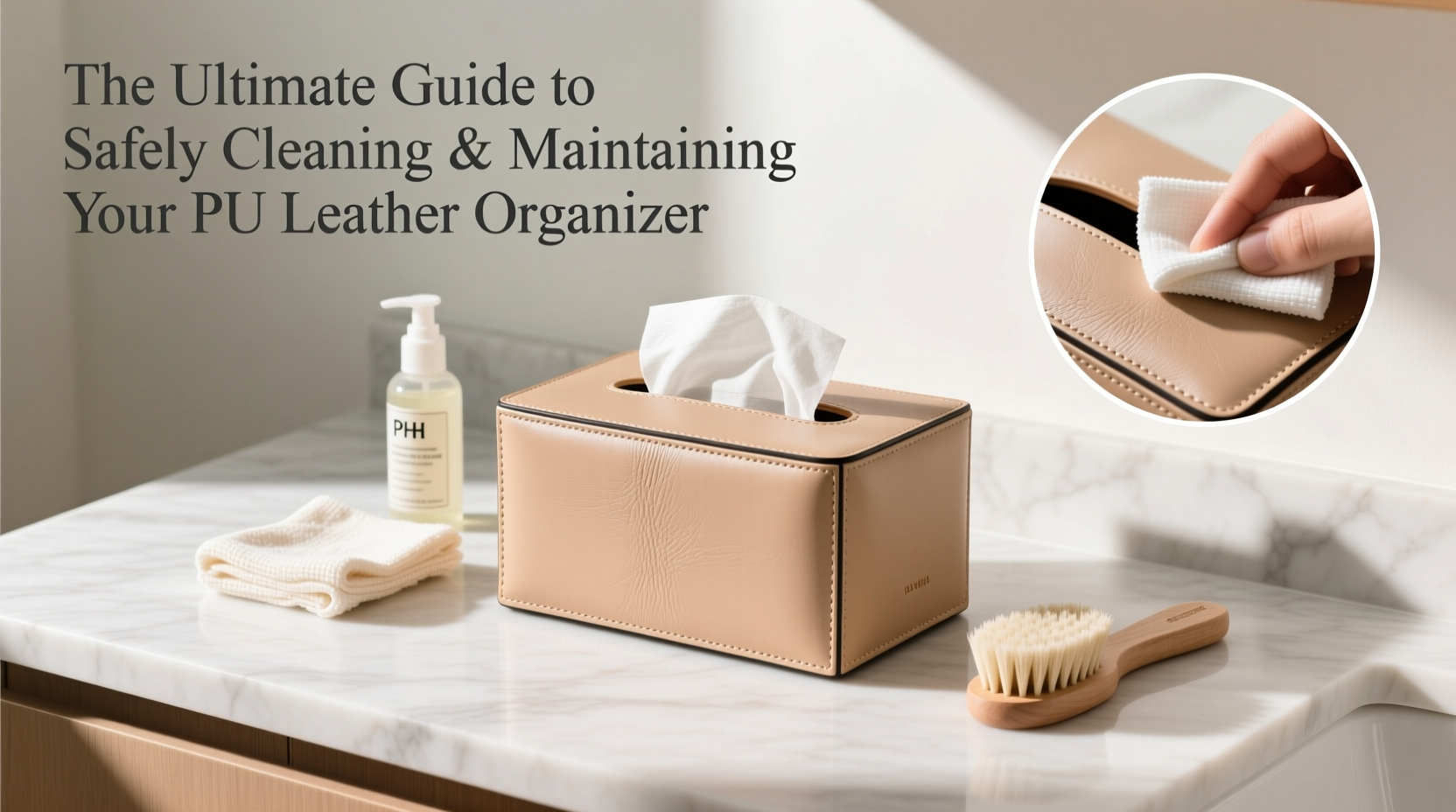PU leather tissue boxes and organizers blend functionality with modern style, adding a touch of sophistication to living rooms, bedrooms, and offices. Unlike genuine leather, polyurethane (PU) leather is a synthetic material designed to mimic the look and feel of real leather while being more affordable and easier to produce. However, its durability depends heavily on proper care. Without regular maintenance, PU leather can crack, peel, or discolor—diminishing both appearance and lifespan. This comprehensive guide delivers actionable strategies to keep your PU leather accessories pristine, from daily upkeep to seasonal deep cleaning.
Understanding PU Leather: What It Is and Why It Needs Special Care

PU leather is a man-made material composed of a split leather or fabric backing coated with a layer of polyurethane. While it offers water resistance and a soft texture, it lacks the breathability and resilience of genuine leather. Over time, exposure to heat, sunlight, oils, and improper cleaning agents can degrade the surface coating, leading to visible wear.
The tissue box and organizer are particularly vulnerable due to frequent hand contact, dust accumulation, and occasional spills. Sweat, hand lotions, and ambient humidity all contribute to surface breakdown. Therefore, understanding the limitations of PU leather is the first step toward preserving its condition.
“PU leather isn’t indestructible—it’s a balance between aesthetics and maintenance. A few minutes of weekly care can prevent years of premature aging.” — Lena Park, Interior Textile Specialist
A Step-by-Step Guide to Safe Cleaning
Cleaning your PU leather tissue box should be a gentle, methodical process. Harsh scrubbing or chemical cleaners can strip the protective topcoat, accelerating deterioration. Follow this six-step routine for consistent results:
- Dust Removal: Use a dry microfiber cloth to wipe down the entire surface. Pay attention to crevices and corners where dust accumulates.
- Prepare a Mild Cleaning Solution: Mix one teaspoon of mild liquid dish soap (without bleach or degreasers) into a cup of lukewarm water.
- Dampen, Don’t Soak: Dip a clean cloth into the solution, then wring it thoroughly until only slightly damp.
- Gentle Wiping Motion: Wipe the surface in straight lines or circular motions—avoid aggressive rubbing. Focus on stained or greasy areas with light pressure.
- Rinse Residue: Use a second cloth dampened with plain water to remove any soapy film. This prevents residue buildup that attracts more dirt.
- Air Dry Naturally: Let the item dry at room temperature, away from direct sunlight or heaters. Never use a hairdryer or fan, as rapid drying can cause cracking.
Do’s and Don’ts: A Quick Reference Table
| Do’s | Don’ts |
|---|---|
| Use a soft microfiber cloth | Use paper towels or rough sponges |
| Clean monthly or when visibly dusty | Wait until heavy staining occurs |
| Apply a PU leather conditioner every 3–4 months | Use silicone-based polishes or waxes |
| Store in a cool, dry place away from windows | Leave in direct sunlight or near radiators |
| Wipe up spills immediately | Allow liquids to sit overnight |
Preventive Maintenance Checklist
Preservation begins long after cleaning. Integrate these habits into your home care routine to extend the life of your PU leather organizer:
- ✅ Dust the surface weekly with a dry microfiber cloth
- ✅ Keep away from high-humidity zones like bathrooms
- ✅ Avoid placing heavy or sharp objects inside that may press into the walls
- ✅ Use a dedicated PU leather conditioner formulated for synthetic materials
- ✅ Rotate placement periodically to prevent uneven fading
- ✅ Cover with a breathable cotton cloth when not in use for extended periods
Real-Life Example: How One Household Extended Their Organizer’s Life by 3 Years
Sarah, a homeowner in Portland, purchased a sleek black PU leather tissue box for her living room. Within eight months, she noticed fine cracks forming along the edges. After consulting a furniture care specialist, she learned she had been using disinfectant wipes—a common household product containing alcohol and solvents known to damage synthetic leathers.
She switched to a regimen of biweekly dusting, monthly mild soap cleaning, and quarterly conditioning with a pH-balanced PU leather cream. She also moved the box away from a south-facing window that exposed it to afternoon sun. Over the next three years, the organizer retained its luster and structural integrity, outlasting two cheaper replacements used in other rooms without such care.
This case illustrates how simple behavioral changes yield dramatic improvements in longevity—even in humid climates or high-traffic homes.
Frequently Asked Questions
Can I use baby wipes to clean my PU leather tissue box?
No. Most baby wipes contain alcohol, fragrances, and preservatives that can dry out and degrade the polyurethane coating. While convenient, they accelerate peeling and discoloration. Stick to a damp microfiber cloth with a homemade or approved cleaner instead.
How do I remove ink stains from PU leather?
Ink requires careful handling. Dab a cotton swab lightly with isopropyl alcohol (70% concentration), then gently blot the stain—do not rub. Immediately follow with a water-dampened cloth to neutralize the alcohol, then air dry. Test on a hidden area first. For large or set-in stains, consult a professional upholstery cleaner.
Is it safe to use a leather conditioner on PU leather?
Only if it's specifically labeled for synthetic or PU leather. Many conditioners contain oils meant for animal hides, which can soften and weaken the adhesive layers in PU materials. Look for water-based formulas free from petroleum distillates.
Conclusion: Small Efforts, Lasting Results
Your PU leather tissue box and organizer are more than just functional items—they’re design elements that reflect your taste and attention to detail. With minimal time investment and the right techniques, you can preserve their appearance and performance for years. The key lies in consistency: regular dusting, cautious cleaning, and smart placement. Avoid shortcuts that seem harmless but compromise material integrity over time.









 浙公网安备
33010002000092号
浙公网安备
33010002000092号 浙B2-20120091-4
浙B2-20120091-4
Comments
No comments yet. Why don't you start the discussion?